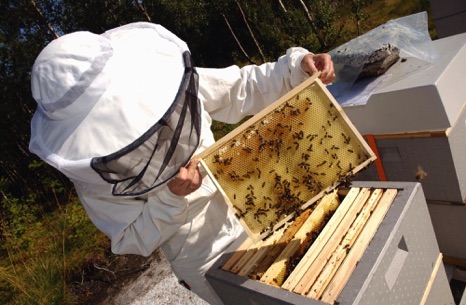

March 26th 2015 - Catch a Buzz!
It must be spring somewhere b ecause it feels like late winter here in Minnesota. However, we seem to trick ourselves into thinking that it is closer than what it might be. For us at this time of year, nice weather, if only 50-60 degrees F, is outright balmy t-shirt weather.
Last weekend we attended a beginning bee-keeping class at the University of Minnesota. We missed out on the first class because it was sold out. Seriously. We'll talk about that in a moment.
What's great about living up here is that we have time to plan during the cold days of winter, the classes and subjects we need to take to ensure we get some basic instruction for our next set of ventures. Everyone is different when it comes to education versus just trying. I like to try and then go back to school, where my partner prefers to get the training before trying. Who's right? Doesn't matter. But on this subject, both of us agreed that we should probably take a class because we have no idea what we are getting into. Nor if we should.
We were looking forward to this class and how beekeeping might help our property management plan as well as maybe getting some honey from these little gals. So when we were commuting to the University my wife says to me that there were 240 students signed up for the class. No kidding? I was not real thrilled about 10 hours of lecture and powerpoint slides. However, when we got there they had this class very well organized.
We weren't expecting that there would be that kind of interest in this topic, however, there is a crisis in this country and around the world, with our pollinators. What is going on is that our two primary honey production bees, that aren't actually native to the US, are under siege and there is a real shortage of bees. Scientists are working hard to understand what kinds of issues are putting mortal pressue on the bee population. It sounds like there are both natural and man-made issues.
There are bacteria and even little parasitic mites that are similar to ticks that weaken the bees. So we learned how to test and how to treat. When they said to scoop up 300 live honey bees, put them in a jar and coat them with powdered sugar...hum. You actually shake out the sugar and count the mites (they're black). The other discussion is the challenges of manmade pesticides. Since they are generally non-discriminatory, it's an issue. Especially when you consider that it's not just the fruit and vegetable plants, but where the stuff goes on the ground that has the clover and dandelions and any other flower plant, shrub or tree. Pollen is the protein source that makes the amino acids and other stuff. Nectar is the sap of the flower that is processed into honey by removing the moisture out of it so it won't ferment and rot. This is the carbohydrates that the bees need to survive our winters when these flower sources are dormant. The cycle of life.
We also learned that there is only one queen to a hive. The queen is made by certain amina acids that this one larvae eats from a super intense carbohydrate that the worker put into this egg. All other eggs get the regular stuff to become a drone or worker bee. The drone is the male bee and only has one purpose. That is to be lucky enough to mate with a queen. Only 5% of the hive are drones. The other 95% are female or referred to as the workers. The queen only flies once or twice in its life. The first flight is to get its bearings of where the hive is and the second is to get mated by 10-20 drones. The drones have no stinger and if they are lucky to score with a queen they basically die. If they don't mate, they still die. And finally, the worker have a barbed stinger. If you do get stung, you need to remove the stinger immediately to lower the level of venom that goes into your system. Also, that worker bee will die as well.
The whole day was fascinating and looks like a new venture that should hold our interest for years ahead. One of the cool things about living in the upper midwest is that we are in the sweet spot for honey production. In places like Washington state, honey production might be 25-35#, Florida might yield 70-80#. The upper plains can see hives producing up to 150-200# per hive worth of honey. Who knew except those who have been beekeeping.
Our bees will arrive in May.
Stay tuned and catch the buzz!
Cheers


